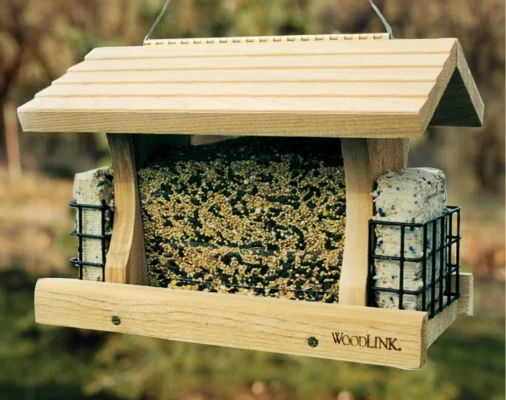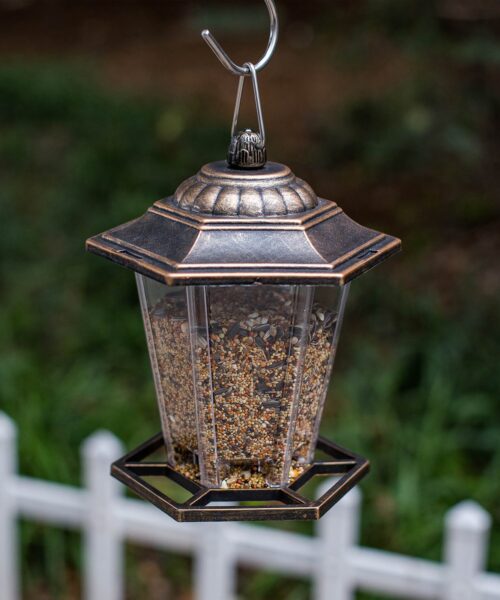Lawn & Garden
Benefits of Having a Backyard Bird Feeder and the Best Types of Feed
 Having a backyard bird feeder not only brings joy and entertainment but also offers several benefits for both birds and bird enthusiasts. Not only do feeders provide a reliable food source for birds, but they also create opportunities for observation, contribute to bird conservation efforts, and enhance the overall biodiversity of your backyard. This article explores the various advantages of having a backyard bird feeder and highlights the best types of feed to attract and nourish different bird species.
Having a backyard bird feeder not only brings joy and entertainment but also offers several benefits for both birds and bird enthusiasts. Not only do feeders provide a reliable food source for birds, but they also create opportunities for observation, contribute to bird conservation efforts, and enhance the overall biodiversity of your backyard. This article explores the various advantages of having a backyard bird feeder and highlights the best types of feed to attract and nourish different bird species.
1. Nourishment and Survival
A bird feeder provides a consistent and accessible food source for birds, especially during times when natural food supplies may be scarce, such as during winter or drought. By offering a variety of nutritious bird feed, you can help birds maintain their energy levels, survive harsh weather conditions, and even assist them during migration.
2. Bird Watching and Education
Installing a bird feeder creates an excellent opportunity for bird watching right from the comfort of your own home. Observing birds in their natural habitat can be a relaxing and educational experience for both adults and children. It offers a chance to learn about different bird species, their behaviors, and their unique characteristics.
3. Conservation and Wildlife Support
Providing a bird-friendly environment in your backyard through a bird feeder contributes to bird conservation efforts. By offering supplemental food, you can help sustain local bird populations, particularly during times when their natural habitats are under threat. Backyard bird feeders also play a role in preserving bird species and promoting biodiversity in urban and suburban areas.
4. Pest Control
Certain bird species are natural predators of insects and pests that may be harmful to your garden or plants. By attracting insect-eating birds to your backyard with a bird feeder, you can create a natural pest control system and reduce the need for harmful chemical pesticides.
Best Types of Feed for Backyard Bird Feeders
When it comes to choosing the right feed for your backyard bird feeder, it’s essential to consider the preferences and dietary needs of different bird species. Here are some popular types of bird feed:
- Sunflower Seeds: Loved by a wide variety of birds, sunflower seeds are highly nutritious and rich in protein and healthy fats. They are especially attractive to finches, cardinals, and chickadees.
- Suet: Suet is a high-energy food that consists of animal fat mixed with various seeds, nuts, and fruits. It is particularly beneficial during the winter months when birds require extra calories to stay warm. Suet feeders attract woodpeckers, nuthatches, and other insect-eating birds.
- Nyjer (Thistle) Seed: Nyjer seed is tiny and oil-rich, making it a favorite among finches, such as goldfinches and siskins. These seeds require specialized feeders with small ports to prevent spillage.
- Fruit and Berry Feeders: Some bird species, like orioles and tanagers, are attracted to fresh fruit and berries. Offering slices of oranges, apples, or hanging berry feeders can entice these colorful visitors to your backyard.
- Mixed Bird Seed: A blend of different seeds, such as millet, cracked corn, and oats, can attract a wide range of bird species, including sparrows, jays, and doves. Ensure the mix is of high quality and does not contain excessive fillers or cheap grains.
Remember to provide fresh and clean water alongside the bird feeder, as birds require hydration in addition to food.
Conclusion
Having a backyard bird feeder offers numerous benefits, from providing nourishment to birds and supporting their survival to creating opportunities for bird watching and contributing to bird conservation efforts. By selecting the right types of feed and maintaining a clean and inviting feeder, you can attract a diverse array of bird species and enjoy the beauty and wonder of nature right in your own backyard.
FAQs
- How do I attract specific bird species to my backyard bird feeder? To attract specific bird species, research their preferred feed and habitat requirements. Tailor your feeder and landscaping choices accordingly to create an inviting environment for your desired birds.
- Are there any birds I should avoid feeding at bird feeders? Some bird species, such as invasive or aggressive birds like European Starlings or House Sparrows, can dominate feeders and outcompete native species. It’s advisable to research local bird populations and consult with local birding organizations to ensure you are promoting the well-being of native bird species.
- How often should I clean my bird feeder? Regular cleaning of your bird feeder is essential to prevent the buildup of bacteria and mold that can be harmful to birds. Clean the feeder and remove any spoiled or wet feed at least once a week or more frequently during humid conditions.
- Can I make my own bird feed? Yes, you can create homemade bird feed using various ingredients such as peanut butter, seeds, fruits, or suet. However, ensure that the feed is appropriate for the bird species you want to attract and that it is free from any harmful additives or chemicals.
- What other steps can I take to create a bird-friendly backyard? In addition to installing a bird feeder, you can create a bird-friendly backyard by planting native vegetation, providing nesting boxes, offering fresh water sources, and minimizing pesticide use. These actions contribute to a healthier and more inviting environment for birds and other wildlife.








